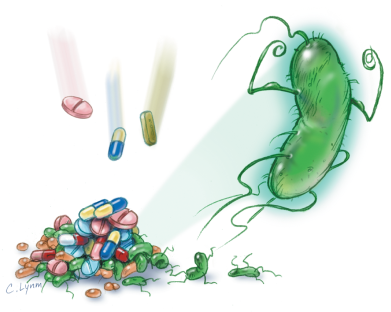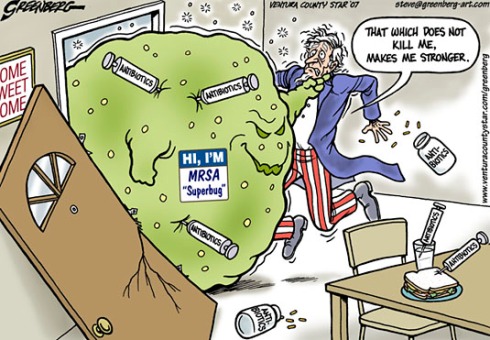… A ticking bomb that probably has already exploded, but no one tells us (and I personally prefer it this way).
Antimicrobial resistance is a very broad term that is used when bacteria, virus, fungi or parasites develop resistance against drugs. In this post I will only mention antibiotics as an example drug and bacteria as an example evil, just for the sake of clarity.
So how does this happen? In order to understand this, let’s see how antibiotics work (oversimplification alert: bare with me if you already know all this)
The magic bullet:
Antibiotics are like magic bullets. Imagine you fire those at a large crowd and only the bad guys die. And that’s pretty much how they work: they target specific aspects of the bacteria that our cells do not possess.
So how can anyone overcome a magic bullet? It is actually about Darwinian evolution. All living things undergo mutations. Mutations happen completely randomly. Most of them are silent. Some of them are beneficial and some are harmful. Especially in unicellular organisms like bacteria, the effects of mutations are immediate.
Wear a magic-bullet-proof vest.
Imagine a mutation that makes a bacterium’s membrane ticker. In a medium where permeability is very important, the organisms who have a mutation like this would immediately be wiped out. But, in a situation where there’s a molecule (the antibiotic) that tries to dig holes into your membrane, this would give you a huge advantage because then you have your own magic bullet proof vest. All those who don’t have it die, and others triumph. This is called the natural selection.
Eat the bullet.
Bacteria produce all sorts of enzymes and they invent new ones all the time. If you submit them to a same molecule over and over, they’ll eventually figure out how to eat it.
And this basically is the problem with the antimicrobial resistance. It is due to two main problems:
- For the bacteria, it is a question on life and death. They must (and will) figure out a way to survive.
- The more they see a molecule, the more likely they are to built resistance against it.
Unfortunately we are not using antibiotics only as medicine. One very, very dark day, farmers realized that when animals were fed antibiotics, they grew heavier. So today, we are fed tons of antibiotics, and by this I really mean tons as a unit of mass (a ton is ~2,000 pounds, if ever anyone from the USA reads my posts 😉 ). The amount of antibiotics we eat in a piece of meat is just plain scary…
This brings us to the main issue. What are we going to do when we will eventually find ourselves where antibiotics no longer work? What can we do when every single petty infection involves multiple drug resistant super bugs?

Punnoose AR, Lynm C, Golub RM. Antibiotic Resistance. JAMA. 2012;308(18):1934. doi:10.1001/jama.2012.6916.
Hiding the bullet:
We obviously need to stop feeding those antibiotics to animals. This is a must. Because it only makes it so that the bacteria see those molecules too often. Due to that, the health personnel of our times are faced with a dilemma. When they have a molecule that still works, they need to hide it. This means that if they have a patient with a pretty bad infection in front of them, they need to limit the treatment to a symptomatic level and wait for him to overcome the infection only with his natural defenses, although, he might end up dead.
This sounds like one of those questions in psychology tests that only psychopaths can answer: “Do you hide the drug and avoid a potential and deadly epidemic, or do you let this one man die?”
(Oh, by the way if you answer this question with the 1st choice, only too quickly, the psychologists will think you are a psychopath… just saying)
If during the 32 years of my existence I understood anything about humanity, I foresee this situation to evolve like this: “Sir, you have a pretty nasty infection and you will probably die. I have a very efficient drug against it in my cupboard and I can give it to you only if you pay one-thousand-gazillion-dollars” (insert a Martin Skhreli smile here).
If bacteria evolve, so must the bullet!
Another strategy to overcome the problem is to find a bullet that can follow the bacteria in their evolution. There are specific viruses, called the bacteriophage, that only target bacteria. Ongoing research aims at using them as antimicrobial drugs. Because for the bacteriophage, this is a question of survival too. If the prey evolves, so must the predator.
Unfortunately though, when I was in college I had a class on evolutionary biology and I remember them mentioning a population modelling on this predator-prey dynamics and saying that eventually the prey always wins… 😦
Mess with enemy communications!
A very popular strategy these days, is to mess with the communications of the bad guys so that they don’t do bad deeds. Bacteria use a system, called quorum sensing to interact with each other. Basically they send each other messenger molecules. When they start to populate a medium (let’s say this is your body) at one point some of them send the others a message saying “Let’s screw this guy!” Once the others receive this molecule they all start secreting toxins!
The idea is to mess with those messenger molecules so that no one gets the memo. Since it is not directly killing bacteria, it is not a life or death situation for them to evolve out of. It s actually very promising 🙂
Let’s see how this will work out…




Great post ! I’m just wondering about the time scale of this evolution. If “only” the next generations of humans are screwed, I’m pretty sure that nobody cares. I think it’s the same problem with all the sensitive topics of our world : global warming, etc. : Let’s save ourselves and let the next generations handle their own problems (that our generations would have caused). Moreover, because we live in a society governed by money, as it would cost too much to change the way we live, we just pretend we don’t see the problem. Which is of course, not a good solution 😥
LikeLiked by 1 person
I totally agree to that 🙂
To answer your question: By “next generation” I mean the kids today. In a scale which goes from past to long term future, this problem can be situated as “immediate”
LikeLiked by 1 person
Pingback: What are these things called “superbugs”? | Deakin Communicating Science 2016